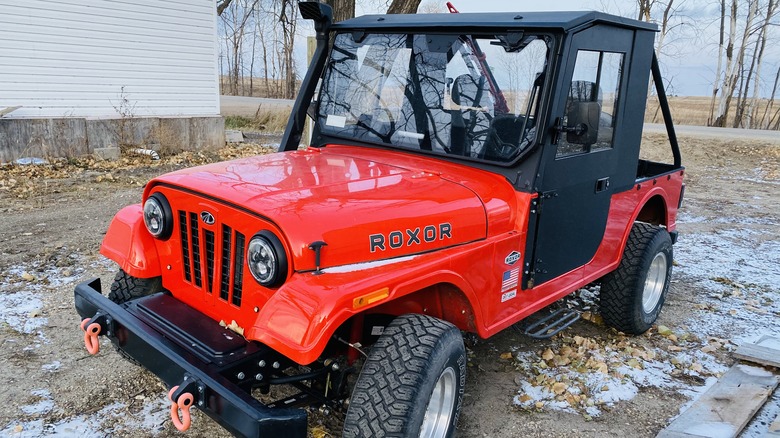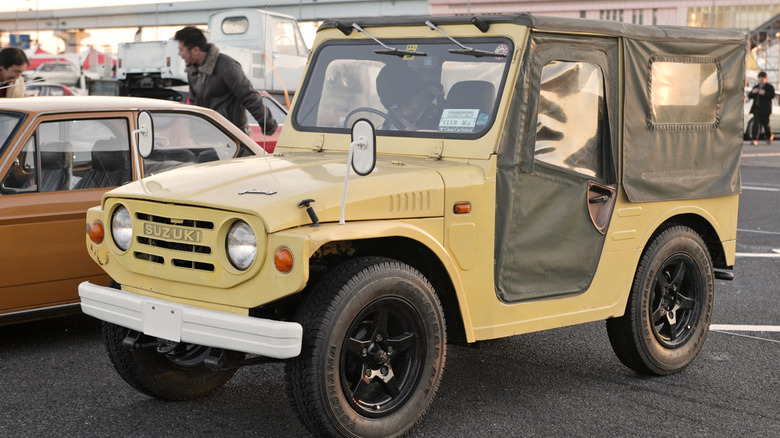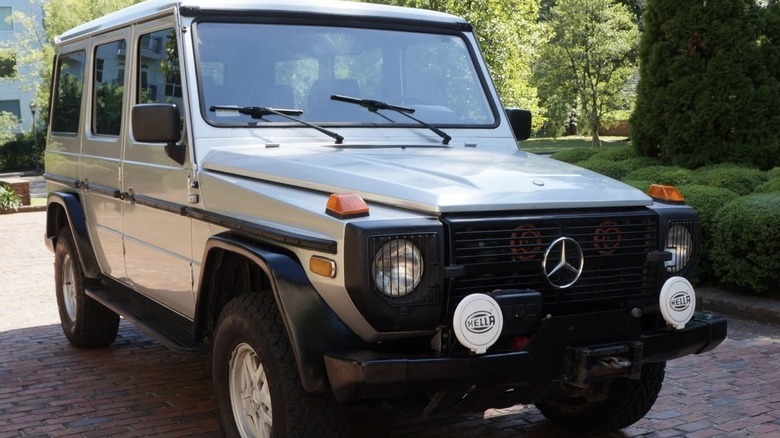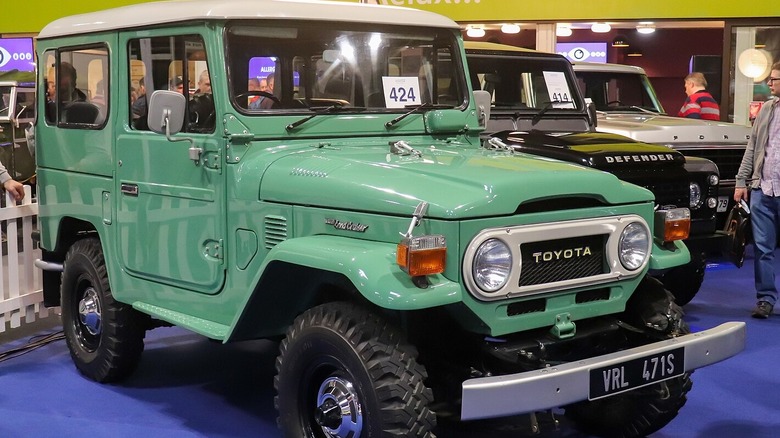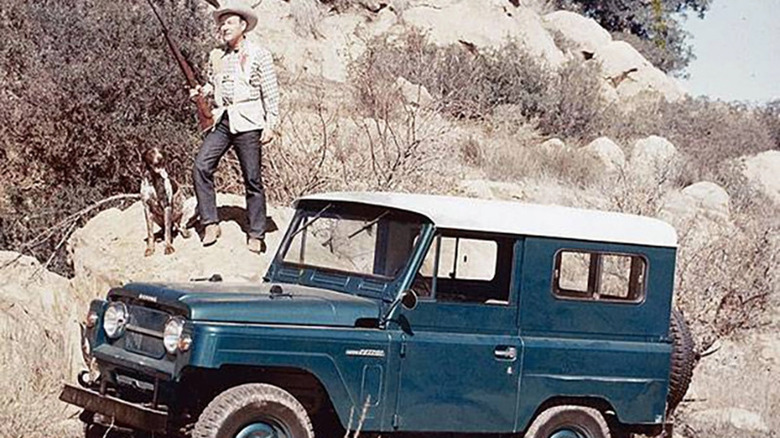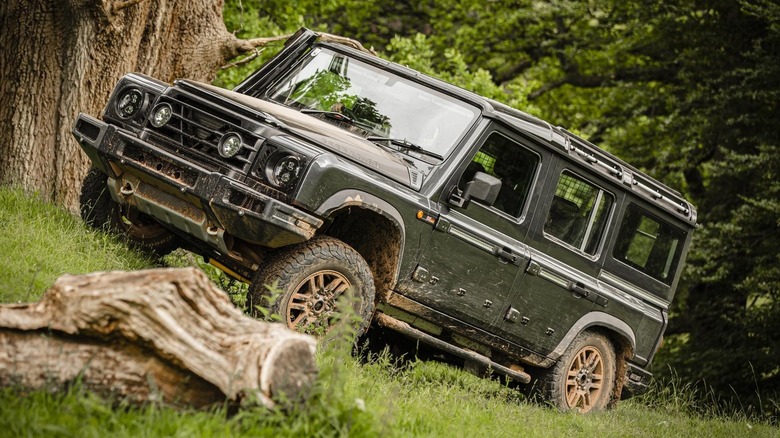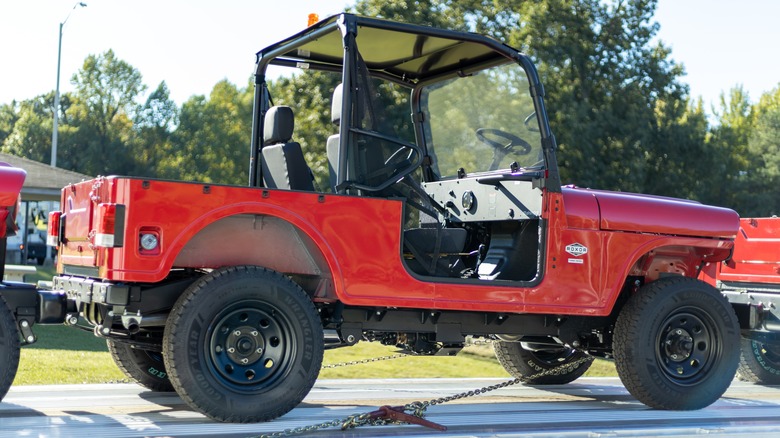5 Cars That Are Basically Jeep Clones
The Jeep brand dates back to the years after World War II, when Willys Overland's troop and light gear carrier evolved into the CJ line of rugged small SUVs. The CJ evolved into the Wrangler, a model that has been in production for over four generations since 1987. These rugged SUVs remain Jeep's most recognizable models, and as the old saying goes, imitation is the sincerest form of flattery.
CJs and Wranglers must be blushing with the awareness that they have inspired a parking lot full of vehicles that could be classified as anything from loose imitations to outright ripoffs. These competitors are all built to go off-road with ease and have adopted the classic Jeep form: stubby, with ample ground clearance and often a removable soft top. We've taken a leisurely, bumpy cruise through automotive history on your behalf to find this assortment of Jeep clones from around the world.
The Suzuki Jimny has become a legend of its own
The Suzuki Jimny began life in 1968 as the Hope Motor Company ON360, but when Suzuki bought Hope, it updated the model and, in 1986, began selling it in the United States as the Samurai. The carbureted 1.3-liter inline four-cylinder engine produced only 63 horsepower and took more than 16 seconds to get the Samurai from 0-60 miles per hour.
The Samurai cost $6,500 that first year (equal to about $19,000 today), which was significantly cheaper than the next year's debut-edition Wrangler. That model cost just over $10,000, making the Samurai a great choice for budget-minded buyers who wanted something fun and distinctive. The Samurai got a price hike to 8,495 in 1988, the same year a rollover crash during a Consumer Reports road test wrecked the Samurai's reputation in the United States. It was discontinued in the U.S. after 1995, but the Jimny lived on elsewhere and is still for sale around the globe.
The Mercedes G-wagon shares the Jeep's military roots
A former Mercedes engineer created the Unimog just after World War II, and the small all-terrain workhorse was so popular in Germany that Mercedes bought the company in 1950. Mercedes has kept making Unimogs in various utilitarian configurations since then and began crafting the G-wagon in 1973. There were initially separate models for military and civilian use, although they were quite similar. The civilian version went into production in 1979 in two-door convertible and two and four-door wagon forms, and an early TV ad showed G-wagons romping through the mud and snow like their American CJ counterparts. Then, in 1980, Mercedes adapted a 230G for use by Pope John Paul II during his visit to Germany, and Jacky Ickx and Claude Brasseur drove a modified 280GE to a win in the 1983 Paris-Dakar Rally.
The G-class stayed relatively middle-class through 1990, when Mercedes gave it a luxury makeover that included wood trim, leather seats, and running boards. A New Mexico company called Europa got permission to import G-wagons to the United States beginning in 1993, but the necessary modifications drove the price past the $100,000 mark (equal to more than $220,000 today). Mercedes began selling the SUVs in the U.S. in 2001, and Mercedes has since produced a six-wheeled version for overseas markets and a V12-powered G65 variant, which is now available worldwide if you have more than $200,000 to spare.
Toyota based the F40 Land Cruiser on the Jeep CJ
It might be a little insulting to call the Toyota Land Cruiser a Jeep clone, but Toyota took more than a passing inspiration from CJ series Jeeps when building this legend. The J40 was the second generation of a long series of Land Cruisers and first appeared in 1960. The Land Cruiser had been born a decade earlier, during the American Army's operations in Korea. The U.S. still had troops in Japan after World War II, and military leaders asked Japanese automakers to make 100 vehicles akin to the Willys and Ford Bantam Jeeps they were using.
This would save transportation costs for further operations in Asia, and Toyota quickly produced the Jeep BJ40 using the Willys CJ as a template. In the summer of 1951, Toyota sent test driver Ichiro Taira to the Mount Fuji Trail, where he became the first person to drive to its sixth checkpoint. Willys objected to Toyota's initial use of the word "Jeep" in the model name and sued Toyota, so the Land Cruiser name was used beginning in 1954. That same year, the model's 3.4-liter inline-six was replaced with a 3.9-liter version that produced 125 horsepower. From 1960 on, FJ40 was used for gas-powered short-body Land Cruisers and BJ40 on diesel models.
The Nissan Patrol is another international sensation
Like the Toyota BJ Jeep, the Nissan Patrol began its long life in 1951. At first, it was called the 4W60 and didn't take on the Patrol name until the third generation 4W65 and 4W66 versions were introduced in 1958. The 4W line gave way to the 60 series in late 1960, and that version stuck around for a full two decades. American buyers could get a 60-series Patrol from 1962 through 1969, and Nissan used Roy Rogers to promote it in its new market. The Patrol 60 series was issued in short and long wheelbase forms and as a pickup, wagon, soft top, and hardtop.
The MQ Patrol 160 replaced the 60 series in 1980, and the Patrol continued to evolve throughout the next few decades. For a long while, the closest thing American buyers could get to a Patrol was the 2017 Armada, a close cousin to the Y62 Patrol that debuted in 2010. Nissan unleashed a high-performance NISMO version of the Patrol as part of the SUV's 50th anniversary celebration in 2021, The U.S. market won't be getting that 428-horsepower beast, but Nissan recently announced that the Patrol in its standard form will be returning to the U.S. market later this year.
The Ineos Grenadier is Land Rover and Jeep inspired
Although most of the vehicles on this list are at least a couple of decades old, the Ineos Grenadier is a more recent Jeep imitator. The Grenadier was unveiled at the 2020 Concourse of Elegance in London, where it sat next to a WIllys Jeep, FJ40 Land Cruiser, and Mercedes G-Wagon. Those other SUVs were all owned by Ineos, and designer Toby Ecuyer admitted they served as direct inspiration for his company's new creation. "At the outset of the Grenadier project, we brought some of the great 4x4s of the past into the studio to look closely at what made them so enduring," he told Autocar. "You can see common design traits and proportions. I think the Grenadier sits very naturally among these 4x4 icons, and if others agree, then we've achieved our design objective."
Ineos Automotive is a division of Ineos, a British chemical company owned by Sir Jim Ratcliffe. Ratcliffe has a famous affinity for Land Rovers; he owns the first one ever produced, which sat neglected for decades before Ratcliffe restored it and took it on a safari trip across Asia.
Unsurprisingly, the Grenadier most resembles a Land Rover Defender, and SlashGear's Michael Teo Van Runkle drove the 2024 Grenadier and felt it compared favorably to contemporary Jeep offerings. "Having spent a ton of seat time in Jeeps, the Grenadier's lack of wind noise, improved interior ergonomics, and pleasing switchgear stands in stark contrast with the prehistoric Fiat-Chrysler design and build quality."
The Mahindra Roxor is a quasi-authorized WIllys clone
Mahindra got into the Jeep business in 1947, when Willys farmed out Asian production of CJ3B models to the Indian automaker. Mahindra began selling a similar vehicle of its own called the Thar and has kept up licensing agreements with every custodian of the Jeep brand since then. Classic Jeep fans in the United States can now buy Mahindra's Roxor, a dead ringer for the CJ models of yore. You'll have to haul it to your favorite off-road spots and enjoy it away from public highways, though. The Roxor isn't street-legal in the U.S. and is intended for use as a farm truck and in other private property settings.
It's far more than your average side-by-side, though. The Roxor has a steel body, 16-inch wheels with BF Goodrich KO2 off-road tires, and an 8,000-pound winch. You can tow up to 3,500 pounds at up to 15 miles per hour in the Roxor; that's 1,500 pounds more than the towing capacity of the 1987-1995 YJ series Wrangler. The Roxor is powered by a 2.7-liter turbodiesel four-cylinder engine and comes in base and all-weather versions.
